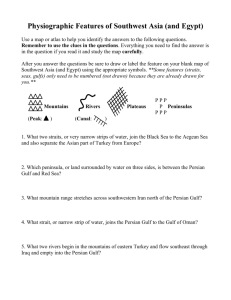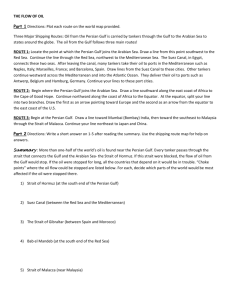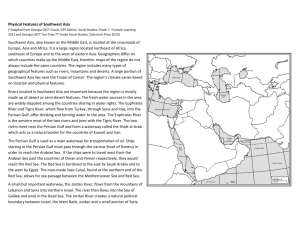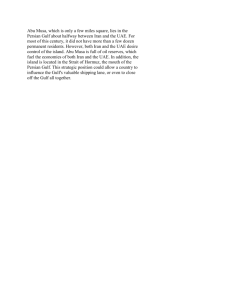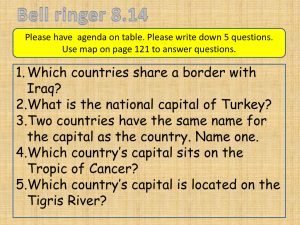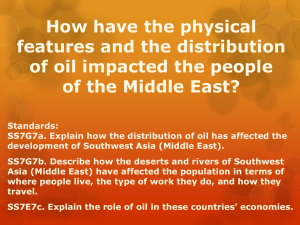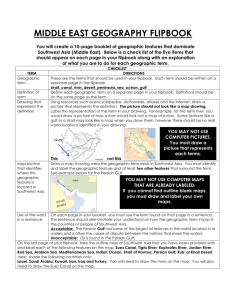File - Mr. Young`s Stuff
advertisement
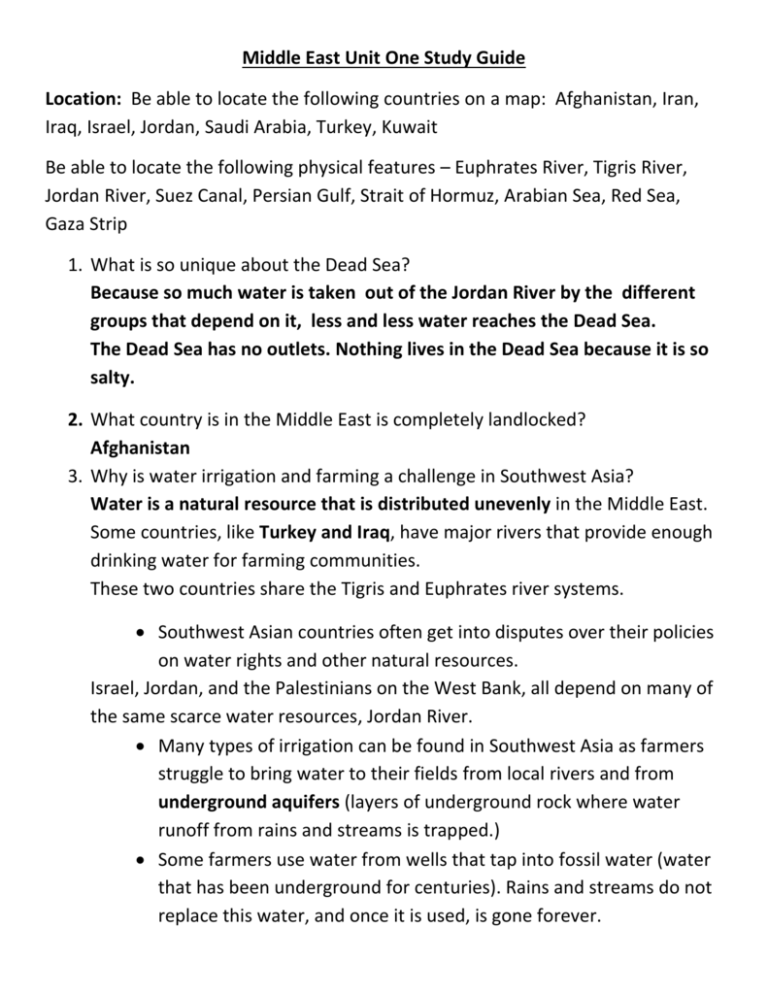
Middle East Unit One Study Guide Location: Be able to locate the following countries on a map: Afghanistan, Iran, Iraq, Israel, Jordan, Saudi Arabia, Turkey, Kuwait Be able to locate the following physical features – Euphrates River, Tigris River, Jordan River, Suez Canal, Persian Gulf, Strait of Hormuz, Arabian Sea, Red Sea, Gaza Strip 1. What is so unique about the Dead Sea? Because so much water is taken out of the Jordan River by the different groups that depend on it, less and less water reaches the Dead Sea. The Dead Sea has no outlets. Nothing lives in the Dead Sea because it is so salty. 2. What country is in the Middle East is completely landlocked? Afghanistan 3. Why is water irrigation and farming a challenge in Southwest Asia? Water is a natural resource that is distributed unevenly in the Middle East. Some countries, like Turkey and Iraq, have major rivers that provide enough drinking water for farming communities. These two countries share the Tigris and Euphrates river systems. Southwest Asian countries often get into disputes over their policies on water rights and other natural resources. Israel, Jordan, and the Palestinians on the West Bank, all depend on many of the same scarce water resources, Jordan River. Many types of irrigation can be found in Southwest Asia as farmers struggle to bring water to their fields from local rivers and from underground aquifers (layers of underground rock where water runoff from rains and streams is trapped.) Some farmers use water from wells that tap into fossil water (water that has been underground for centuries). Rains and streams do not replace this water, and once it is used, is gone forever. Many people in the Middle East practice subsistence agriculture, growing small amounts of crops, to take care of their local needs. Because the climate is so dry, agriculture nearly always depends on irrigation, directing water from small rivers and streams to the farmers’ fields. There is some commercial agriculture (growing crops for industrial markets), but even that is limited by lack of water. 4. Why is the Strait of Hormuz an important waterway? Any ships coming out of or into the Persian Gulf must navigate through the very narrow Strait of Hormuz, located at one end of the Persian Gulf. This waterway connects the Persian Gulf to the Arabian Sea. 5. Before the Suez Canal was built, how did ships go from the Persian Gulf to Europe? Around Africa The Persian Gulf is one of the main ways oil is shipped from the rich fields of Kuwait, Saudi Arabia, Iran, and other countries that line its shores. All of the countries that produce oil in that region depend on the Persian Gulf and the Strait of Hormuz as a shipping route. 6. Describe the climate of the Middle East. The countries of the Middle East generally have a very hot and dry climate. The climate is the type of weather a region has over a very long period. Even so, mountain ranges close to many of the coastal areas block rains coming from these bodies of water and the result is that much of the interior of this region is desert. Because there are coastal areas as well as a number of large rivers, other parts of this region have enough water to support agriculture and towns and cities of significant size. Some people have always managed to live in and around the desert, living in tent camps and surviving as sheep and camel herders and making a living by trading animals and handmade goods with those who lived in the towns on the desert’s edge. 7. Three continents are Europe, Africa, and Asia 8. Mediterranean Sea and Red Sea 9. Most people live where there is plentiful water for irrigation/farming, water for trade, and natural resources such as oil and natural gas. Section 2 – Environmental issues and climate of the Middle East Vocabulary: Semi –Arid---- hot , dry with some rainfall Arid--- hot, dry with very little rainfall Peninsula ---- a piece of land surrounded by water on three sides. Oasis---– a place in a desert where water is available near the surface. Dam – Structure built along a river to hold water and use it for irrigation, drinking water, and hydroelectricity. Drought – long period of time without rain. Strait- narrow body of water connecting two larger bodies of water Canal-Manmade waterway connecting two larger bodies of water 1. Define some problems with water usage and rights in Southwest Asia? Countries are fighting over water to use for irrigation to grow crops. Disagreements on who has the rights to the water? Countries upstream (Turkey) setting up dams or downstream upset about pollution or lack of water. 2. Why is oil so important? Two of the most important natural resources found in Southwest Asia are natural gas and oil. These two resources bring wealth into the region because they are needed for much of the world’s economy. Oil is the largest natural resource in Southwest Asia. Drilling oil from the ground requires heavy machinery that often endangers the environment with pollution and toxins. 3. What influences the standard of living in the Middle East? The amount of oil and natural gas a country has The amount of fresh water and availability to sea ports for trade 4. What is OPEC? Why is it important? In the 1960s, several of these Southwest Asian countries joined with other oil-rich countries around the world to create the Organization of Petroleum Exporting Countries (OPEC) in order to have more control over the price of oil on the world market. Nations with the greatest reserves of natural gas and oil are Saudi Arabia, Iraq, Iran, and Kuwait. Those countries without oil reserves have a much harder time improving living conditions for their populations. Long Answer Questions 1. Describe how the deserts and rivers of the Middle East have affected the population in terms of where people live, the type of work they do, and how they travel. As countries in the Middle East have worked to modernize their systems of agriculture, water pollution has been a growing problem. Increased demand for irrigation to expand farming has led to overuse of rivers and streams. Many farmers have begun to use chemical fertilizers, which have contaminated water supplies through runoff into these same rivers and streams. Constant planting and fertilizer use have led to the build-up of salt levels in soils, eventually making it impossible to farm in those areas. Dams built along a river to create lakes for irrigation and the production of hydroelectric power (electricity produced from the energy of running water)Turkey in one country reduce the amount of water available to other countries-Iraq located further downstream. Even so, mountain ranges close to many of the coastal areas block rains coming from these bodies of water and the result is that much of the interior of this region is desert. Because there are coastal areas as well as a number of large rivers, other parts of this region have enough water to support agriculture and towns and cities of significant size. The Middle East has a number of very large deserts areas: the Syrian Desert shared between Syria and Iraq, and the Rub al-Khali, or ” Empty Quarter,” in southern Saudi Arabia. Some people have always managed to live in and around the desert, living in tent camps and surviving as sheep and camel herders and making a living by trading animals and handmade goods with those who lived in the towns on the desert’s edge. 2. Why is the Strait of Hormuz an important waterway? The Persian Gulf is one of the main ways oil is shipped from the rich fields of Kuwait, Saudi Arabia, Iran and many other countries that line its shores. All of the countries that produce oil in that region depend on the Persian Gulf as a shipping route. Any ships coming out of the Persian Gulf must navigate through the very narrow Strait of Hormuz, located at the end of the Persian Gulf. This waterway connects the Persian Gulf to the Arabian Sea.
